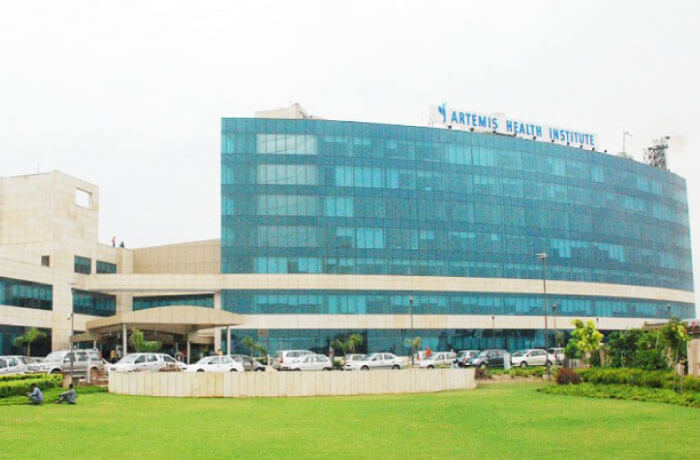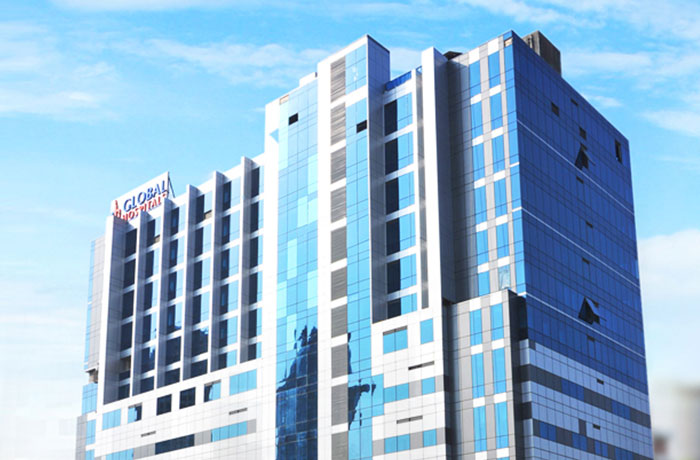Spine
Lumbar Discectomy Treatment
Spine or Disc Surgery
Lumbar discectomy is a surgical procedure performed to remove a herniated or degenerative disc in the lower spine. The surgeon approaches the spine from posterior, through the back muscles. Your doctor may recommend a discectomy if physical therapy or medication fail to relieve leg or back pain that is caused by inflamed and compressed spinal nerves.
Overview
Lumbar discectomy is a surgical process to remove a herniated or degenerative disc in the lower spine. The incision is made posterior, through the back muscles, to remove the disc
pressing on the nerve, to remove the patient's discomfort. A discectomy may be recommended if physical therapy or medication fails to relieve leg or back pain or if the patient has
any signs of nerve damage, such as weakness or loss of feeling in his/her legs. The surgery can be performed either in an open or in minimally invasive technique. The traditional
surgery is called an open discectomy. Open discectomy is an operation where the surgeon uses a small incision and looks at the actual herniated disc in order to remove the disc
thereby relieve the pressure on the nerve. Disc herniation occurs when a fragment of the normal spinal disc is dislodged; this fragment may press against the spinal cord or the
nerves that surround the spinal cord. This pressure is the root cause of the symptoms that are characteristic of herniated discs, including electric shock pain, numbness and
tingling, and weakness.
What is Lumbar Discectomy?
Discectomy in layman language means cutting out the disc. A discectomy can be performed anywhere along the spine from the neck to the low back. The surgeon reaches the damaged disc
from the back of the spine through the muscles and bone. The surgeon accesses the damaged disc by removing a portion of the lamina. After this, the spinal nerve is retracted to one
side. Depending on the particular case, one disc or more can be removed. A variety of surgical tools and techniques are used to perform a discectomy. An open technique uses a large
skin incision and muscle retraction so that the surgeon can directly view the affected area. A minimally invasive technique or a microendoscopic discectomy only uses a small skin
incision. A minimally invasive incision causes less disruption of the back muscles and also helps in decreasing the recovery time.
Fusion may be performed at the same time as discectomy to help stabilize the spine for patients who are athletes, perform heavy labor, or have spinal instability. Fusion uses a
combination of bone graft and screws (plates) to connect two vertebrae together. During the healing process, the two vertebrae will fuse into one piece of bone. Fusion is generally
not required for a herniated lumbar disc.
Procedure:
Before the Surgery:
• The Patient may be scheduled for presurgical tests (e.g., blood test, electrocardiogram, chest X-ray) several days before the surgery takes place.
• The Surgeon must be correct medical history (allergies, medicines/vitamins, bleeding history, anesthesia reactions, and previous surgeries) by the patient.
• The patient must discuss all medications (prescription, over-the-counter, and herbal supplements) that he/she is taking.
• All non-steroidal anti-inflammatory medicines (Naprosyn, Advil, Motrin, Nuprin, Aleve, etc.) and blood thinners (Coumadin, Plavix, etc.) must be avoided 1 to 2 weeks before
surgery as directed by the doctor.
• Additionally, smoking, chewing tobacco, and drinking alcohol must be prohibited 1 week before and 2 weeks after the surgery because these activities can cause bleeding problems.
• No food or drink is permitted past midnight the night before surgery takes place.
Morning of surgery
• Shower with the help of antibacterial soap. Wear loose fitting and freshly washed clothes.
• Wear flat-heeled shoes having closed backs.
• If the patient has been given instructions to take regular medication the morning of surgery, do so with small sips of water.
• Remove any make-up, hairpins, contacts, body piercings, nail polish, etc.
• Leave all valuables and jewelry at home.
• Patient must have a list of medications with dosages and the times of day usually taken.
• Patient must have a list of allergies to medication or foods.
• Arrive at the hospital 2 hours prior to the scheduled surgery time to complete the necessary paperwork and pre-procedure work-ups.
During The Surgery:
A discectomy is performed under general anesthesia; this surgery might take up to an hour, depending on the extent of the disc herniation, the size of the patient, and other
factors. A discectomy is performed with the patient lying face down, and the back pointing upwards. In order to remove the fragment of a herniated disc, the surgeon will make an
incision over the center of your back. The incision is generally about 3 centimeters in length. The surgeon then carefully dissects the muscles away from the bone of the spine.
Using special instruments, the surgeon removes a small amount of bone and ligament from the back of the spine. This part of the procedure is known as a laminectomy. Once this bone
and ligament are removed, the surgeon can see and thereby protect the spinal nerves. Once the disc herniation is found out, the herniated a disc fragment is removed. Depending on
the appearance and the condition of the remaining disc, more disc material can be removed in hopes of avoiding another fragment of a disc from herniating in the future. Once the
disc has been cleaned out from the area around the nerves, the incision is closed and a bandage is applied to avoid any contamination.
Recovery:
Herniated disk surgery is very effective, and it works faster than other treatments. The patient will start to see an improvement in symptoms like pain, weakness, and numbness
within a few weeks after surgery.
Physical therapy or rehab can help in quicker recovery. The patient may visit a rehab center, or perform exercises at home. Walking can also help in regain movement in the spine.
In the first few weeks after the surgery, be careful:
• Do NOT Lift heavy objects,
• Do NOT Sit for a longer time span,
• Do NOT Bend or stretch too much.
The patient's doctor will let him/her know when he/she can drive, go back to work, and do other things. The patient should be able to go back to a desk job in 2 to 4 weeks. They
might have to wait for 6 to 8 for lifting any heavy objects.
What are the Risks associated with Lumbar Discectomy?
• No surgery is without risks.
• A general complication of any surgery includes bleeding, infection, blood clots, and reactions to anesthesia.
• If a spinal fusion is performed at the same time as a discectomy, there is a greater risk of complications.
Specific complications related to a discectomy may include:
• Deep vein thrombosis: DVT is a serious condition caused when blood clots form inside the leg veins. If the clots break free and travel to the lungs, lung collapse or even death in
adverse condition. However, there are several ways to treat and prevent DVT. Support hose and pulsatile stockings can keep the blood from pooling in the veins to avoid blood cloth.
Drugs, such as aspirin, Heparin, or Coumadin, may also be used to avoid clotting.
• Lung problems: Lungs needs to be working their best after surgery to provide tissues with enough oxygen to heal. If the lungs have collapsed areas, mucus and bacteria build up
which can lead to pneumonia. The nurse will encourage the patient to breathe deeply and cough often.
• Nerve damage or persistent pain: Any operation on the spine comes with the risk of damaging the nerves or spinal cord; damage in the spinal cord can cause numbness or even
paralysis at the worse condition. However, the most common cause of this persistent pain is nerve damage from the disc herniation itself. Some disc herniation may permanently damage
a nerve making it unresponsive to decompressive surgery. In these cases, spinal cord stimulation or other treatments may help provide relief to the patient. There is a small chance
that surgery won't improve your symptoms. Or, your pain might get better for a while but come back in the future. Surgery can provide most people relief from pain and other
symptoms. Yet it does not work for everyone. In very few cases, the disk will herniate again.
Although surgery offers faster relief than other treatments, it isn't always the best option. Talk to the doctor before undergoing surgery, it merits and demerits must be discussed
properly.
TREATMENT-RELATED QUESTIONS
GetWellGo will provide you end-to-end guidance and assistance and that will include finding relevant and the best doctors for you in India.
A relationship manager from GetWellGo will be assigned to you who will prepare your case, share with multiple doctors and hospitals and get back to you with a treatment plan, cost of treatment and other useful information. The relationship manager will take care of all details related to your visit and successful return & recovery.
Yes, if you wish GetWellGo can assist you in getting your appointments fixed with multiple doctors and hospitals, which will assist you in getting the second opinion and will help you in cost comparison as well.
Yes, our professional medical team will help you in getting the estimated cost for the treatment. The cost as you may be aware depends on the medical condition, the choice of treatment, the type of room opted for etc. All your medical history and essential treatment details would be analyzed by the team of experts in the hospitals. They will also provide you with the various types of rooms/accommodation packages available and you have to make the selection. Charges are likely to vary by the type of room you take.
You have to check with your health insurance provider for the details.
The price that you get from GetWellGo is directly from the hospital, it is also discounted and lowest possible in most cases. We help you in getting the best price possible.
No, we don't charge patients for any service or convenience fee. All healthcare services GetWellGo provide are free of cost.
Top Doctors for Spine
Top Hospitals for Spine
Contact Us Now!
Fill the form below to get in touch with our experts.



